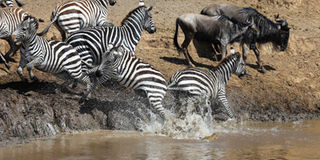A witness to the migration

Zebras and wildebeests flee from a crocodile at the Maasai Mara National Reserve, Kenya, Nov. 24, 2013.
What you need to know:
It’s a beautiful time to be in the Mara, for the big cats are well-fed in this time of bounty.
We watch a lioness gorge on a full-grown zebra, ripping through its skin and pulling out the organs, her muzzle red with blood when she looks up.
A pair of silver-back jackal and a spotted hyena stay close by, trying to inch in on the kill.
It’s the start of August and the wildebeest will begin their return journey to the Serengeti from the Mara plains, trekking through Mara’s 1,500-square kilometre reserve.
We’ve chosen Mara Safari Club in Ol Chorro Conservancy to view the migration, landing at Ngerende airstrip.
Within minutes of landing we’re whisked off to the club, driving along the banks of the Mara River. In the cool of the morning, a huge herd of about 20 hippos enjoy the morning sun. To the untrained eye, the pod could pass for boulders.
We arrive at the Mara Safari Club, and I’m midway through my breakfast when a huge crocodile carried by the current floats by followed by three enormous hippos. Interesting.
Later on I enjoy a massage by the Mara river. The river’s flow is soothing – it’s the source of life here and beyond. It is what the Nile is to the Egyptians, and has been since the Pharaonic times.
The Mara inevitably flows into the Nile, starting its journey from the Mau highlands and 385 kilometres through Masai country and Tanzania and into Lake Victoria – and we all know that the source of the Nile is Lake Victoria.
Then we’re off to watch the dramatic crossing. Over a million wildebeest, zebra and antelopes come to the Mara from across the Serengeti to drink from its perennial waters for it is the only source of water.
It’s a beautiful time to be in the Mara, for the big cats are well-fed in this time of bounty.
We watch a lioness gorge on a full-grown zebra, ripping through its skin and pulling out the organs, her muzzle red with blood when she looks up.
A pair of silver-back jackal and a spotted hyena stay close by, trying to inch in on the kill. A mother with her playful cubs lounges on a termite mound, the naughtier of the two cubs running up and down the hill and teasing its sibling. There’s a pair of lionesses that look so much like twin-sphinxes on an islet in the river.
But it’s the wildebeest that hold us captive for now. By the steep banks of the river, the congregating gnus and zebra come to the edge of the river, drink and run back up the slope.
Everybody waits patiently. Tourists in another vehicle play cards when suddenly, one herd decides it’s now or never and make a daring dash for the other side in search of fresh grass. The fat crocodile that until now has been lying immobile swims like lightning to the file. Suddenly, a gnu seems to be grappling with something in the water. It surfaces, it’s brought down, it disappears in
Factfile
Log on www.fairmont.com or call +254 20 226 5555 for more about the Fairmont Mara Safari Club.
Visit the two southern white rhino – Kofi Annan and Elizabeth (after the British queen) at the conservancy – and you can have pictures taken close to them.




